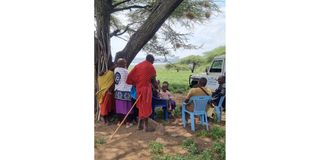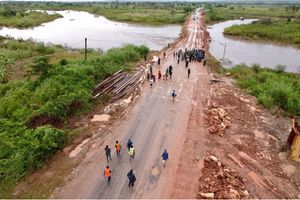Tanzania’s swift response to rabies offers the world a lesson: report

A vaccination exercise taking place in the affected areas through a mobile clinic. PHOTO | COURTESY
Dar es Salaam. In March 2021, an outbreak of rabies emerged at a village in Tanzania’s Ngorongoro Conservation Area, a protected area where semi-nomadic pastoralist communities coexist with wildlife. But if not for the doctors’ clinical suspicion of rabies and quick reporting of the case, many lives would have been put at risk.
A12-year-old boy showing symptoms consistent with rabies had arrived at the Foundation for African Medicine & Education (FAME), a hospital in Karatu, prompting doctors to act swiftly in engaging communities, conducting contact tracing and preventing the spread.
An account of the successful response to the outbreak is contained in a new interactive report, dubbed: Epidemics That Didn’t Happen, produced by a global public health initiative Resolve To Save Lives, which has highlighted lessons the rest of the world can learn from Tanzania in preventing Global Epidemics by Stopping Infectious Diseases at the start.
The report says that until rabies is eliminated in Tanzania using sustainable and cost-effective strategies such as dog vaccination, the strategic action undertaken by the response team demonstrates how a rabies outbreak can be contained.
Thanks to coordination of a multidisciplinary team in Tanzania, an outbreak of the viral disease was controlled, providing a model for collaborative public health response in effectively preventing a possible epidemic.
This story, like many other prevented epidemics, didn’t make the headlines even in Tanzania where an estimated that 1,500 people die each year from rabies, popular as ‘kichaa cha umbwa’. The true number of deaths could be much higher, experts say.
The government aims to eliminate rabies in the country by 2030, with strategies including sustained mass vaccination of dogs and increasing access to preventive medicine.
The new report by Resolve to Save Lives celebrates successful, real-life outbreak responses, like the swift action taken in Tanzania, and highlights different aspects of effective public health programs in many countries, such as Guinea, DRC, India, Burkina Faso, Brazil and Indonesia.
“Successes of front-line public health workers around the world prove that public health works when we invest in and prioritize strengthening health systems—especially at the national and subnational levels,” said Dr. Tom Frieden, President and CEO of Resolve to Save Lives and former Director of the US Centers for Disease Control and Prevention.
“Our report demonstrates that responses don’t have to be perfect to be effective, but sustained investment in preparedness can mean the difference between an outbreak that’s contained and one that devastates a community, a country, or the world. Epidemic preparedness must not stop when an outbreak does.”
When outbreaks aren’t contained, the results can be economically catastrophic as well as deadly: estimates place the global cost of COVID-19 as high as $20 trillion, with approximately 20 million lives lost.
However, research from Resolve to Save Lives found that it would cost approximately $124 billion over five years to make the world much better prepared for disease threats—a bargain that could save countless lives and preserve economies.
“Outbreaks begin and end locally, so community action is crucial to preventing epidemics. Public health officials’ engagement with communities pays off because it builds trust in the health system,” said Amanda McClelland, Senior Vice President of Resolve to Save Lives.
“Another key component is protecting health care workers, who are the frontline of defense against outbreaks. When primary health care centers are safe work environments, patients and health care workers are protected and are better able to detect and respond to health threats before they spiral out of control.”
The case studies were developed with support from health ministries and global health organizations including, Indonesian Red Cross Society, International Federation of Red Cross and Red Crescent Societies, Vital Strategies and FAME Hospital





